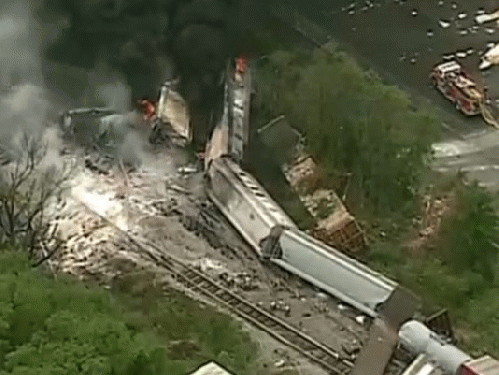Yesterday afternoon, a 15-car train derailed outside Baltimore, Maryland, causing a massive explosion and damaging several surrounding buildings. This latest incident follows on a commuter train collision in Connecticut on May 17, the collapse of a highway bridge in Washington on May 23, and a train collision and overpass collapse in Missouri on May 25.
In yesterday's accident, a train carrying chemicals reportedly struck a garbage truck and derailed in an industrial area east of Baltimore. The crash caused several of the cars to catch on fire, which later exploded and sent a plume of smoke into the air visible from several miles away. Although no deaths have yet been reported, the driver of the truck struck by the train had been taken to a trauma center at the University of Maryland and was reported to be in serious condition.
Mike Veader, who was standing in the parking lot of a nearby church when the explosion occurred, told the Baltimore Sun that it resembled the one which occurred at the West, Texas fertilizer plant last month: "The ball of fire looked kind of like the one in Texas, the same thing."
Baltimore Fire Chief John Hohman told the AP that two of the burning cars were carrying teraphaelic acid and fluorcyclic acid. At least one of the cars was carrying sodium chlorate, a hazardous chemical which is used to bleach paper, but was not in one of the burning cars. Nevertheless, Baltimore County spokeswoman Elise Armacost stated that the smoke did not contain toxic inhalants. Fire officials stated that the blaze was expected to continue into the night.
Several accidents have occurred in this area before. One year ago, a man was struck and killed by a train in Rosedale. On August 21, two people were killed after a train derailed west of the city. In 2001, a fire occurred in a tunnel after 60 cars derailed.
On Saturday, two commercial freight trains struck one another at a crossing in rural Missouri roughly 125 miles south of St. Louis. The collision caused 12 cars to derail -- some of which also caught on fire -- and to knock out the support pillar of a highway overpass, causing it to collapse.
The National Transportation Safety Board (NTSB) has said that the investigation into the causes of the wreck could take as long as a year. Although two cars were on the overpass at the time of its failure, both their occupants and two train workers luckily experienced only minor injuries.
The Connecticut train collision on May 17, for its part, resulted in 70 injuries, two of which were critical. Incredibly, a worker for the same rail service, the Metro-North Railroad, was struck and killed by a train yesterday, again in Connecticut. The Metro-North is the busiest commuter railway in the US in terms of monthly ridership and operates between New York City and its surrounding suburbs.
Roughly 1,000 people in the US die in train accidents every year, while train derailments resulting in chemical spills take place nearly every two weeks.
On top of the recent spate of train disasters, a bridge over the Skagit River outside Seattle, Washington collapsed last Thursday after a truck carrying an oversize load struck a support girder. Although not officially rated as "structurally deficient," the bridge, built in 1955, was listed as "functionally obsolete" by the National Bridge Inventory Database. In other words, it was not built for current demands and standards. In an attempt at a defense, Washington Secretary of Transportation Lynn Peterson said that there were "a number" of bridges along the Skagit River which had a lower rating.
The growing frequency of such incidents points not only to the acutely advanced decay and increasingly hazardous state of US infrastructure, but also to the utter unwillingness of the political establishment to meaningfully address the situation.
In 2007, following the collapse of the Minnesota 1-35 bridge, which plunged 100 cars into the Mississippi River, killing 13 and injuring a further 145, the chairman of the NTSB promised that the lessons of that disaster would "provide a roadmap to prevent future tragedies."
Nevertheless, following the financial crash in 2008, infrastructure spending as a percentage of GDP plummeted to its lowest point in at least 20 years. State and local governments, which had provided around 75 percent of the funds for transportation and water projects in the early 1990s and 2000s, have since reined in that spending: in California, for example, transportation spending fell by 31 percent between 2007 and 2009.





